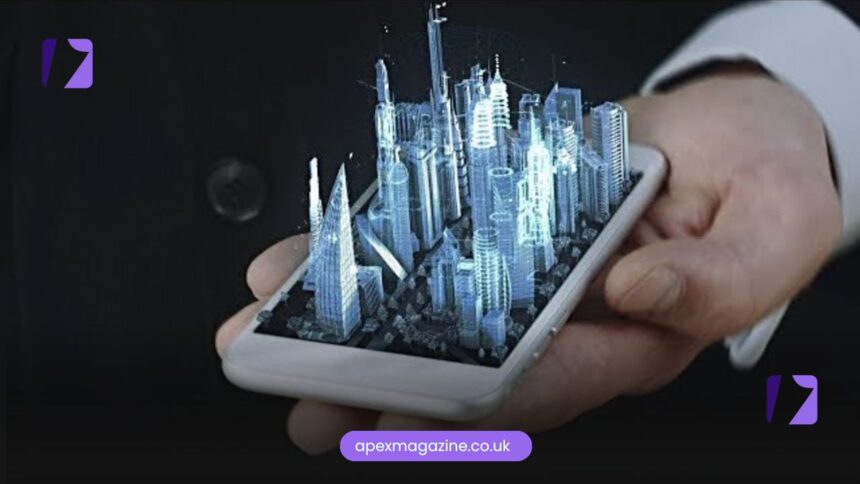In a world where science fiction increasingly blends with everyday life, hologram tech stands out as one of the most captivating innovations. Imagine attending a concert where your favorite artist performs right in your living room, or surgeons manipulating 3D models of organs during complex operations. As we step into 2025, hologram tech is no longer confined to blockbuster movies like Star Wars it’s becoming a tangible part of our digital landscape. From interactive displays at CES to groundbreaking research in UK universities, this technology is reshaping how we interact with information, entertainment, and even healthcare.
Hologram tech, at its core, creates lifelike three-dimensional images that appear to float in space, offering depth and realism that traditional screens can’t match. With advancements accelerating, especially in regions like the UK where companies. Institutions are leading the charge, it’s worth diving deep into what makes this possible. In this comprehensive guide, we’ll explore the history, mechanics, applications, recent breakthroughs, future prospects, and challenges of hologram tech. Whether you’re a tech enthusiast in London or a professional seeking practical insights. Understanding hologram tech could unlock new possibilities in your field.
What Is Hologram Tech?
In simple terms, hologram technology is a technique that creates three-dimensional images that appear to float in space without needing special glasses. These visuals are made using light diffraction, lasers, and digital projection systems.
Unlike regular 3D images, holograms provide depth, parallax, and motion that make the visuals feel real. You can walk around them and view them from multiple angles, giving an illusion of physical presence.
At its core, hologram tech is all about capturing and reconstructing light fields. When a laser light beam splits and records the interference pattern of an object. That information can be projected later to recreate the image in mid-air.
How Hologram Tech Works
The process behind holography might sound complex, but here’s the simplified version:
- Recording the object: A laser beam is split into two parts one illuminates the object, while the other serves as a reference beam.
- Capturing the interference: When these beams meet, they form a unique interference pattern that encodes the depth and dimensions of the object.
- Reconstruction: When another beam of light passes through the recorded interference, it recreates the image as a 3D hologram visible to the naked eye.
Modern digital holography goes beyond traditional laser setups. It uses digital projectors, AR displays, and AI-driven reconstruction to make real-time holograms possible — even through smartphone cameras or LED stages.
The Background of Hologram Tech: From Concept to Reality
To truly appreciate hologram tech, we need to start with its foundations. The journey begins in the mid-20th century, rooted in the pursuit of better imaging techniques. Hungarian-British scientist Dennis Gabor is widely credited as the father of holography. In 1947, while working at the British Thomson-Houston company in Rugby, England. Gabor developed the theory of holography to improve the resolution of electron microscopes. His work earned him the Nobel Prize in Physics in 1971, but at the time, the technology lacked a crucial element: a coherent light source.
The breakthrough came in the 1960s with the invention of the laser. In 1962, American scientists Emmett Leith and Juris Upatnieks at the University of Michigan created the first practical optical hologram using off-axis techniques, allowing for clearer 3D reconstructions. This marked a shift from theoretical concepts to real-world applications. Early holograms relied on silver halide photographic plates, capturing light interference patterns that, when illuminated, recreated the original scene in stunning detail.
Throughout the 1970s and 1980s, holography evolved from lab experiments to artistic and commercial uses. Museums and galleries began showcasing holographic art, while security features like those on credit cards emerged. In the UK, institutions like the Holocenter and companies such as Display Hologram played pivotal roles in advancing the field. By the 1990s, digital holography took center stage, integrating computers to generate and manipulate holograms without physical objects.
How Hologram Tech Works: The Science Behind the Magic
At first glance, holograms seem like sorcery, but they’re grounded in physics—specifically, the principles of light interference and diffraction. Unlike a standard photograph that captures light intensity from a single viewpoint, hologram tech records both the intensity and phase of light waves, creating a full 3D reconstruction.
The process starts with a laser beam split into two: the reference beam and the object beam. The object beam illuminates the subject, scattering light that interferes with the reference beam on a recording medium, such as a photographic plate or digital sensor. This interference pattern, invisible to the naked eye, encodes the 3D information. When illuminated by a similar laser or even white light in some cases, the hologram diffracts the light to recreate the original wavefront, making the image appear three-dimensional.
Modern hologram tech often uses digital methods, where computers calculate interference patterns for virtual objects. Devices like spatial light modulators (SLMs) project these patterns, enabling dynamic holograms that change in real-time. For example, in volumetric displays, light is scattered in mid-air using particles or layered screens, allowing viewers to see images from any angle without glasses.
One fascinating aspect is the “touchable” hologram. Recent innovations, like those demonstrated in 2025, use ultrasound or air vortices to add haptic feedback, letting users feel the projections. In the UK, research at the University of St Andrews has pioneered metasurface-based holograms that could integrate into smartphones, making high-quality 3D displays compact and affordable.
Current Applications of Hologram Tech: Transforming Industries
Hologram tech is already making waves across various sectors, proving its versatility beyond novelty. In entertainment, companies like Musion 3D in the UK have brought deceased. Artists back to the stage, such as Tupac at Coachella or Whitney Houston in tours. These “holographic” performances use Pepper’s Ghost illusions combined with high-definition projections, creating lifelike appearances.
In medicine, hologram tech enhances diagnostics and surgery. Surgeons can project 3D models from MRI scans, rotating and zooming in for better planning. At Imperial College London, holographic imaging has been used in cardiac procedures, reducing operation times and improving accuracy. Globally, systems like those from EchoPixel allow interactive exploration of patient anatomy, potentially saving lives in remote areas.
Education benefits immensely, with holographic lectures at Loughborough University in the UK thrilling students by projecting AI-powered avatars of professors. Imagine history classes where ancient artifacts appear in 3D, or biology lessons dissecting virtual organs without mess.
Security and data storage are other key areas. Holograms on banknotes and IDs are hard to counterfeit due to their complex patterns. In data storage, holographic memory can hold terabytes in small spaces, far surpassing traditional hard drives.
Marketing and retail use hologram tech for immersive ads. HYPERVSN, a London-based firm, creates floating 3D displays for stores, drawing customers with eye-catching visuals. In automotive design, companies like ZEISS showcase holographic interiors at expos, allowing virtual test drives.
Here’s a quick overview of applications:
| Sector | Key Uses | Examples |
|---|---|---|
| Entertainment | Live performances, virtual events | Musion 3D concerts |
| Healthcare | Surgical planning, medical training | 3D organ models in UK hospitals |
| Education | Interactive lessons, remote teaching | Hologram lecturers at Loughborough |
| Security | Anti-counterfeiting, authentication | Holographic IDs |
| Retail | Advertising, product demos | HYPERVSN displays in London shops |
| Data Storage | High-capacity archives | Terabyte holographic discs |
These applications demonstrate hologram tech’s practical impact, especially in geo-targeted markets like the UK, where innovation hubs foster rapid adoption.
For a visual on medical uses:

Advancements in Hologram Tech: What’s New in 2025
2025 has been a banner year for hologram tech, with breakthroughs pushing boundaries. At CES 2025, Holoconnects unveiled the Holobox, a transparent touchscreen projecting real-time 3D holograms for communication. This device, blending video calls with holography, could revolutionize remote work.
Researchers at the University of St Andrews in Scotland developed a pixel breakthrough combining OLEDs with metasurfaces, enabling smartphone-integrated holograms. This makes displays smaller, cheaper, and more efficient, addressing long-standing size issues.
Touchable holograms are another milestone. In April 2025, scientists created mid-air 3D graphics manipulable by hand, using acoustic levitation for feedback. Stanford’s work on AI-enhanced holograms promises more realistic mixed-reality experiences.
In the UK, Envisics is advancing holographic head-up displays for cars, overlaying AR navigation on windshields. These advancements, driven by geo-specific research funding, position the UK as a leader in hologram tech.
The Future of Hologram Tech: Horizons Ahead
Looking forward, hologram tech could redefine daily life. Smartphones with built-in holographic projectors might become standard, allowing 3D video calls or gaming without headsets. In business, holographic meetings could eliminate travel, with avatars interacting in virtual spaces.
Healthcare might see holographic telemedicine, where doctors “beam” into remote clinics. Education could go global with interactive holographic classrooms. However, ethical concerns, like deepfake holograms, must be addressed.
Challenges and Limitations in Hologram Tech
Despite progress, hologram tech faces hurdles. High costs for equipment and production limit accessibility. Technical issues, like requiring specific lighting or viewing angles, hinder widespread use.
Miniaturization remains a challenge; integrating holograms into wearables demands powerful yet tiny components. Ethical dilemmas, including privacy in holographic recordings, add complexity. In the UK, regulatory frameworks are evolving to balance innovation with safety.
Overcoming these will require collaborative efforts, but the potential rewards are immense.
Conclusion
Hologram tech represents a leap toward a more immersive, interactive world. From its humble beginnings in 1947 to 2025’s touchable displays, it has evolved into a tool with endless possibilities. As applications expand in healthcare, education, and beyond—particularly in innovative hubs like the UK—hologram tech promises to enhance how we connect, learn, and create. While challenges persist, the trajectory is clear: this technology will shape our future. Embracing it now could position you at the forefront of the next digital revolution.
FAQs
What is a hologram?
A hologram is a three-dimensional image created by recording light interference patterns, allowing it to appear as if it’s floating in space.
How many lasers do you need to make a hologram?
Typically one, but multiple can be used for complex, multi-color holograms on the same medium.
Is hologram tech the same as augmented reality?
Not exactly; holograms recreate light fields for true 3D, while AR overlays digital elements on the real world, often using screens.
Can holograms be touched?
Recent advancements allow interaction via haptic feedback, making them “touchable” in controlled setups.
What are the main applications of hologram tech?
They include entertainment, medical imaging, education, security, and data storage.
Will hologram tech be in smartphones soon?
Yes, breakthroughs like metasurface pixels suggest integration into devices by the late 2020s.
Stay connected with Apex Magazine for the latest in cutting-edge tech and innovations.









